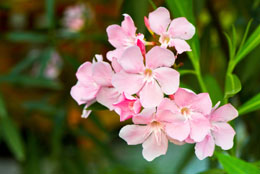Oleander tree is a very attractive plant, that is very easy to grow, and take care of. If looked after properly, it grows up to be a hedge or a small tree. Read this informative Buzzle article to know all about it.

Oleander tree or
Nerium oleander is an evergreen plant which belongs to the Apocynaceae family. The tree is one of the most poisonous houseplants. It is also known by many names such as the La adelfa, rose laurel, rosebay, and olean. Always termed as an attractive plant for warm climates, the oleander bears heavily scented colorful flowers in summer and fall.
This tree grows from summer to fall, and bears flowers which sport a variety of colors like apricot, copper, pink, red, purple, salmon, yellow, and white. It grows best in the western and southern states of the US. They are very well adapted to drought conditions, and withstand muddy winds, and soils which have a high water and salt content. It is a popular attraction in coastal areas. They are not native to the US, but have a broad stretch from Morocco, Portugal, and Mediterranean regions. It is also found in southeast Asia, and is an added attraction along the great highways of California.
The tree is very easy to grow, is adaptable, and requires low maintenance. It can survive without water for weeks. Oleander plants are very poisonous, since there are numerous toxic compounds in every part of the plant's body. The highest rate of poisonous compounds are found in the sap, which can cause skin numbness. Even slight contact with its flowers and leaves, can make you fall sick or have itching reactions all over the body. Therefore, it is advised that you plant them in a place, where no one comes in contact with it.
The ideal planting time is just after the spring. However, planting it after September should be avoided. The white oleander is very popular in Europe, and can be found in almost all lawns and parks. The huge contrast between the colors of the leaves and flowers, makes its beauty impossible to miss.
Care
The tree requires very little water to survive. Watering it twice a week is more than enough. The tree has been said to have survived many drought conditions. However, such climatic conditions have many adverse effects on it, like reduction in flower production and growth rate. If you have an oleander in your backyard, treating them with fertilizers may help the tree grow bigger, and more flowery. Use a layer of compost under the plant in each spring. If you want to retain moisture and practice weed control, add a 2 inch layer of mulch.
Use a balanced fertilizer that has phosphorus, nitrogen, and potassium in equal quantities, and follow the instructions printed on the package for using it. Also, watch for oleander caterpillars as they can destroy your tree within two weeks. Cut off affected leaves and branches, and pick the caterpillars with your hands, and place them in a plastic bag. If you want to kill these caterpillars, place this bag in a freezer for 24 hours, or use a pesticide which contains bacillus thuringiensis. Before using the insecticide, read the package instructions carefully.
Pruning
Proper pruning of the tree will reward you with a strong and healthy tree, which will give you a lot of bloom. The ideal season for pruning an oleander tree is September or early October. Cut the tree just above its leaf nodes; this is the section where new leaves sprout from the branches. Cutting the leaf nodes here, forces a new branch to grow. Three new branches will grow where three new leaves were supposed to grow. Let those branches grow a little more, and prune them again at the leaf nodes. This way, you will again encourage the growth of new branches. This is how you get round and busy branches.
Make sure your first pruning should be not excessive. These trees are resistant to heavy pruning. So, the more you prune, the more flowers it will give and more bushier it will become. Always wear protective eye gear and gloves while pruning, and avoid eating any unknown fruits that are found on plants and trees in your lawn as most of them could be poisonous and can cause many health complications.
In spite of all the poisonous properties that they possess, oleander trees are one of the most common trees in Europe and America. If you have small kids and pets in your house, make sure that they steer clear of this tree.






 Oleander tree or Nerium oleander is an evergreen plant which belongs to the Apocynaceae family. The tree is one of the most poisonous houseplants. It is also known by many names such as the La adelfa, rose laurel, rosebay, and olean. Always termed as an attractive plant for warm climates, the oleander bears heavily scented colorful flowers in summer and fall.
Oleander tree or Nerium oleander is an evergreen plant which belongs to the Apocynaceae family. The tree is one of the most poisonous houseplants. It is also known by many names such as the La adelfa, rose laurel, rosebay, and olean. Always termed as an attractive plant for warm climates, the oleander bears heavily scented colorful flowers in summer and fall.